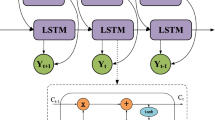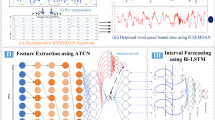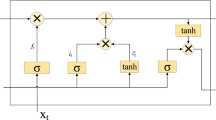Abstract
Wind energy is considered as one of the most attractive renewable energies and has the fastest development in power fields. It gradually becomes an indispensable source for society, especially for generating electricity. Due to the fluctuation of this energy, forecasting wind speed is necessary to adjust wind power accordingly. In this paper, a hybrid model using a Bidirectional Long-Short Term Memory network (Bi-LSTM) with the Complete Ensemble Empirical Mode Decomposition method (CEEMD) to make a multi-step forecast for wind speed in Vietnam was proposed. Initially, the CEEMD method was used to decompose original historical data into a set of constitutive series. Then, the decomposed components were the inputs for the Bi-LSTM model to make a prediction. Bi-LSTM network could utilize the information in both forward and backward directions completely. The performances of the proposed model were compared with that of other models. The final results demonstrated that the forecasting accuracy of the proposed model was higher than the comparative methods.
Access this chapter
Tax calculation will be finalised at checkout
Purchases are for personal use only
Similar content being viewed by others
References
Nguyen, T.H.T., Nakayama, T., Ishida, M.: Optimal capacity design of battery and hydrogen system for the DC grid with photovoltaic power generation based on the rapid estimation of grid dependency. Int. J. Electr. Power Energy Syst. 89, 27–39 (2017). https://doi.org/10.1016/j.ijepes.2016.12.012
Chen, Y., et al.: 2-D regional short-term wind speed forecast based on CNN-LSTM deep learning model. Energy Convers. Manag. 244, 114451 (2021). https://doi.org/10.1016/j.enconman.2021.114451
Koçak, K.: Practical ways of evaluating wind speed persistence. Energy 33(1), 65–70 (2008). https://doi.org/10.1016/j.energy.2007.07.010
Al-deen, S., Yamaguchi, A., Ishihara, T.: A physical approach to wind speed prediction for wind energy forecasting. J. Wind Eng. 108, 349–352 (2006)
Sideratos, G., Hatziargyriou, N.D.: An advanced statistical method for wind power forecasting. IEEE Trans. Power Syst. 22(1), 258–265 (2007). https://doi.org/10.1109/TPWRS.2006.889078
Hu, S., et al.: Hybrid forecasting method for wind power integrating spatial correlation and corrected numerical weather prediction. Appl. Energy 293, 116951 (2021). https://doi.org/10.1016/j.apenergy.2021.116951
Balakrishna Moorthy, C., Agrawal, A., Deshmukh, M.K.: Artificial intelligence techniques for wind power prediction: a case study. Indian J. Sci. Technol. 8(25) (2015). https://doi.org/10.17485/ijst/2015/v8i25/87891
Liu, H., Tian, H.-Q., Chen, C., Li, Y.: A hybrid statistical method to predict wind speed and wind power. Renew. Energy 35(8), 1857–1861 (2010). https://doi.org/10.1016/j.renene.2009.12.011
Grigonytė, E., Butkevičiūtė, E.: Short-term wind speed forecasting using ARIMA model. Energetika 62 (2016). https://doi.org/10.6001/energetika.v62i1-2.3313
Zafirakis, D., Tzanes, G., Kaldellis, J.K.: Forecasting of wind power generation with the use of artificial neural networks and support vector regression models. Energy Procedia 159, 509–514 (2019). https://doi.org/10.1016/j.egypro.2018.12.007
Jónsson, T., Pinson, P., Nielsen, H., Madsen, H.: Exponential smoothing approaches for prediction in real-time electricity markets. Energies 7(6), 3710–3732 (2014). https://doi.org/10.3390/en7063710
Shahid, F., Zameer, A., Muneeb, M.: A novel genetic LSTM model for wind power forecast. Energy 223, 120069 (2021). https://doi.org/10.1016/j.energy.2021.120069
Peng, T., Zhang, C., Zhou, J., Nazir, M.S.: An integrated framework of Bi-directional long-short term memory (BiLSTM) based on sine cosine algorithm for hourly solar radiation forecasting. Energy 221, 119887 (2021). https://doi.org/10.1016/j.energy.2021.119887
Zhen, H., Niu, D., Wang, K., Shi, Y., Ji, Z., Xu, X.: Photovoltaic power forecasting based on GA improved Bi-LSTM in microgrid without meteorological information. Energy 231, 120908 (2021). https://doi.org/10.1016/j.energy.2021.120908
Du, J., Cheng, Y., Zhou, Q., Zhang, J., Zhang, X., Li, G.: Power load forecasting using BiLSTM-attention. IOP Conf. Ser.: Earth Environ. Sci. 440, 032115 (2020). https://doi.org/10.1088/1755-1315/440/3/032115
Soundarapandian, V., Srie, E., Janani, V.: A review on the hybrid approaches for wind speed forecasting. Int. J. Sci. Technol. Res. 8, 1584–1590 (2020)
Liu, D., Niu, D., Wang, H., Fan, L.: Short-term wind speed forecasting using wavelet transform and support vector machines optimized by genetic algorithm. Renew. Energy 62, 592–597 (2014). https://doi.org/10.1016/j.renene.2013.08.011
Jiang, Y., Huang, G.: Short-term wind speed prediction: hybrid of ensemble empirical mode decomposition, feature selection and error correction. Energy Convers. Manag. 144, 340–350 (2017). https://doi.org/10.1016/j.enconman.2017.04.064
Huang, N., et al.: The empirical mode decomposition and the Hilbert spectrum for nonlinear and non-stationary time series analysis. In: Proceedings of the Royal Society of London. Series A: Mathematical, Physical and Engineering Sciences, vol. 454, pp. 903–995 (1998). https://doi.org/10.1098/rspa.1998.0193
Yeh, J.-R., Shieh, J.-S., Huang, N.: Complementary ensemble empirical mode decomposition: a novel noise enhanced data analysis method. Adv. Adapt. Data Anal. 2, 135–156 (2010). https://doi.org/10.1142/S1793536910000422
Hochreiter, S., Schmidhuber, J.: Long short-term memory. Neural Comput. 9, 1735–1780 (1997). https://doi.org/10.1162/neco.1997.9.8.1735
Acknowledgement
This research is funded by Hanoi University of Science and Technology (HUST) under grant number T2021-PC-004.
Author information
Authors and Affiliations
Corresponding author
Editor information
Editors and Affiliations
Rights and permissions
Copyright information
© 2023 The Author(s), under exclusive license to Springer Nature Switzerland AG
About this paper
Cite this paper
Thu, N.T.H., Van, P.N., Bao, P.Q. (2023). Multi-step Ahead Wind Speed Forecasting Based on a Bi-LSTM Network Combined with Decomposition Technique. In: Huang, YP., Wang, WJ., Quoc, H.A., Le, HG., Quach, HN. (eds) Computational Intelligence Methods for Green Technology and Sustainable Development. GTSD 2022. Lecture Notes in Networks and Systems, vol 567. Springer, Cham. https://doi.org/10.1007/978-3-031-19694-2_50
Download citation
DOI: https://doi.org/10.1007/978-3-031-19694-2_50
Published:
Publisher Name: Springer, Cham
Print ISBN: 978-3-031-19693-5
Online ISBN: 978-3-031-19694-2
eBook Packages: Intelligent Technologies and RoboticsIntelligent Technologies and Robotics (R0)




